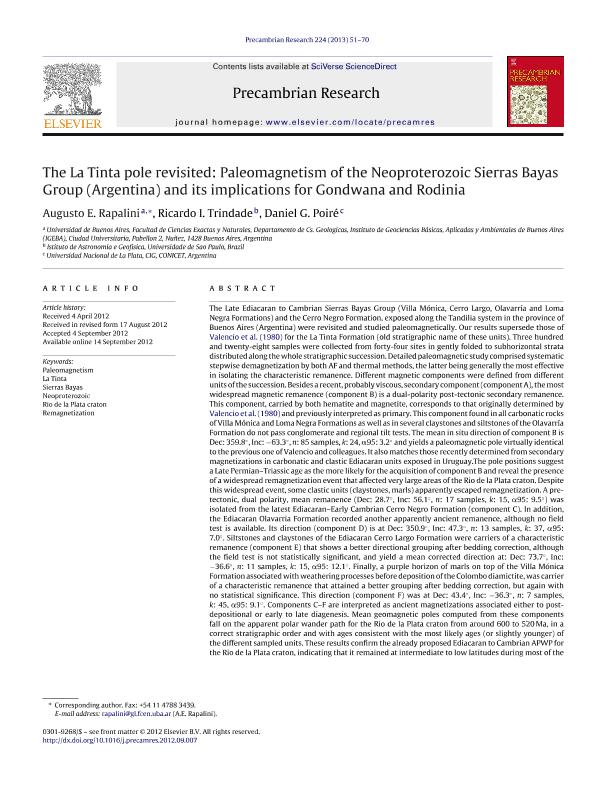Mostrar el registro sencillo del ítem
dc.contributor.author
Rapalini, Augusto Ernesto

dc.contributor.author
Trindade, Ricardo
dc.contributor.author
Poire, Daniel Gustavo

dc.date.available
2017-06-21T18:28:13Z
dc.date.issued
2013-01
dc.identifier.citation
Rapalini, Augusto Ernesto; Trindade, Ricardo; Poire, Daniel Gustavo; The La Tinta pole revisited: Paleomagnetism of the Neoproterozoic Sierras Bayas Group (Argentina) and its implications for Gondwana and Rodinia; Elsevier Science; Precambrian Research; 224; 1-2013; 51-70
dc.identifier.issn
0301-9268
dc.identifier.uri
http://hdl.handle.net/11336/18549
dc.description.abstract
The Late Ediacaran to Cambrian Sierras Bayas Group (Villa Mónica, Cerro Largo, Olavarría and Loma Negra Formations) and the Cerro Negro Formation, exposed along the Tandilia system in the province of Buenos Aires (Argentina) were revisited and studied paleomagnetically. Our results supersede those of Valencio et al. (1980) for the La Tinta Formation (old stratigraphic name of these units). Three hundred and twenty-eight samples were collected from forty-four sites in gently folded to subhorizontal strata distributed along the whole stratigraphic succession. Detailed paleomagnetic study comprised systematic stepwise demagnetization by both AF and thermal methods, the latter being generally the most effective in isolating the characteristic remanence. Different magnetic components were defined from different units of the succession. Besides a recent, probably viscous, secondary component (component A), the most widespread magnetic remanence (component B) is a dual-polarity post-tectonic secondary remanence. This component, carried by both hematite and magnetite, corresponds to that originally determined by Valencio et al. (1980) and previously interpreted as primary. This component found in all carbonatic rocks of Villa Mónica and Loma Negra Formations as well as in several claystones and siltstones of the Olavarría Formation do not pass conglomerate and regional tilt tests. The mean in situ direction of component B is Dec: 359.8°, Inc: −63.3°, n: 85 samples, k: 24, α95: 3.2° and yields a paleomagnetic pole virtually identical to the previous one of Valencio and colleagues. It also matches those recently determined from secondary magnetizations in carbonatic and clastic Ediacaran units exposed in Uruguay. The pole positions suggest a Late Permian–Triassic age as the more likely for the acquisition of component B and reveal the presence of a widespread remagnetization event that affected very large areas of the Rio de la Plata craton. Despite this widespread event, some clastic units (claystones, marls) apparently escaped remagnetization. A pre-tectonic, dual polarity, mean remanence (Dec: 28.7°, Inc: 56.1°, n: 17 samples, k: 15, α95: 9.5°) was isolated from the latest Ediacaran–Early Cambrian Cerro Negro Formation (component C). In addition, the Ediacaran Olavarria Formation recorded another apparently ancient remanence, although no field test is available. Its direction (component D) is at Dec: 350.9°, Inc: 47.3°, n: 13 samples, k: 37, α95: 7.0°. Siltstones and claystones of the Ediacaran Cerro Largo Formation were carriers of a characteristic remanence (component E) that shows a better directional grouping after bedding correction, although the field test is not statistically significant, and yield a mean corrected direction at: Dec: 73.7°, Inc: −36.6°, n: 11 samples, k: 15, α95: 12.1°. Finally, a purple horizon of marls on top of the Villa Mónica Formation associated with weathering processes before deposition of the Colombo diamictite, was carrier of a characteristic remanence that attained a better grouping after bedding correction, but again with no statistical significance. This direction (component F) was at Dec: 43.4°, Inc: −36.3°, n: 7 samples, k: 45, α95: 9.1°. Components C–F are interpreted as ancient magnetizations associated either to post-depositional or early to late diagenesis. Mean geomagnetic poles computed from these components fall on the apparent polar wander path for the Rio de la Plata craton from around 600 to 520 Ma, in a correct stratigraphic order and with ages consistent with the most likely ages (or slightly younger) of the different sampled units. These results confirm the already proposed Ediacaran to Cambrian APWP for the Rio de la Plata craton, indicating that it remained at intermediate to low latitudes during most of the Ediacaran. Comparison with coeval paleomagnetic poles from other cratons indicate that by 575 Ma the Rio de la Plata and Congo-Sao Francisco cratons were likely a single plate. It also strongly argues against the generally accepted model that the Rio de la Plata craton was part of the conjugate margin of Eastern Laurentia during the final stages of Rodinia break-up at around 580 Ma.
dc.format
application/pdf
dc.language.iso
eng
dc.publisher
Elsevier Science

dc.rights
info:eu-repo/semantics/openAccess
dc.rights.uri
https://creativecommons.org/licenses/by-nc-sa/2.5/ar/
dc.subject
Paleomagnetism
dc.subject
La Tinta
dc.subject
Sierras Bayas
dc.subject
Neoproterozoic
dc.subject.classification
Geoquímica y Geofísica

dc.subject.classification
Ciencias de la Tierra y relacionadas con el Medio Ambiente

dc.subject.classification
CIENCIAS NATURALES Y EXACTAS

dc.title
The La Tinta pole revisited: Paleomagnetism of the Neoproterozoic Sierras Bayas Group (Argentina) and its implications for Gondwana and Rodinia
dc.type
info:eu-repo/semantics/article
dc.type
info:ar-repo/semantics/artículo
dc.type
info:eu-repo/semantics/publishedVersion
dc.date.updated
2017-06-21T15:33:30Z
dc.journal.volume
224
dc.journal.pagination
51-70
dc.journal.pais
Países Bajos

dc.journal.ciudad
Amsterdam
dc.description.fil
Fil: Rapalini, Augusto Ernesto. Consejo Nacional de Investigaciones Científicas y Técnicas. Oficina de Coordinación Administrativa Ciudad Universitaria. Instituto de Geociencias Basicas, Aplicadas y Ambientales de Buenos Aires. Universidad de Buenos Aires. Facultad de Ciencias Exactas y Naturales. Instituto de Geociencias Basicas, Aplicadas y Ambientales de Buenos Aires; Argentina
dc.description.fil
Fil: Trindade, Ricardo. Universidade de Sao Paulo; Brasil
dc.description.fil
Fil: Poire, Daniel Gustavo. Consejo Nacional de Investigaciones Científicas y Técnicas. Centro Científico Tecnológico Conicet - La Plata. Centro de Investigaciones Geológicas. Universidad Nacional de la Plata. Facultad de Ciencias Naturales y Museo. Centro de Investigaciones Geológicas; Argentina
dc.journal.title
Precambrian Research

dc.relation.alternativeid
info:eu-repo/semantics/altIdentifier/doi/https://doi.org/10.1016/j.precamres.2012.09.007
dc.relation.alternativeid
info:eu-repo/semantics/altIdentifier/url/http://www.sciencedirect.com/science/article/pii/S0301926812002227
Archivos asociados
